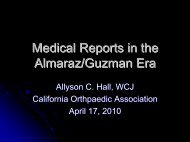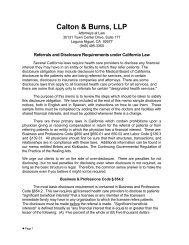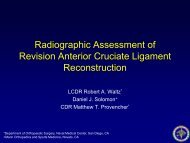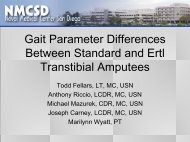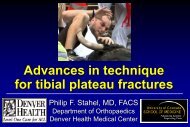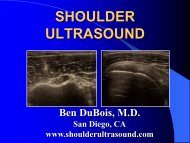Enhancing Your Practice's Revenue - California Orthopaedic ...
Enhancing Your Practice's Revenue - California Orthopaedic ...
Enhancing Your Practice's Revenue - California Orthopaedic ...
- No tags were found...
Create successful ePaper yourself
Turn your PDF publications into a flip-book with our unique Google optimized e-Paper software.
have to be replaced periodically. The cost of plates can befrom $1,000 to $3,000 depending on the size of the plate.Direct radiography (DR) units do not have any of thesecosts. However, the up-front costs of DR units are, at presentat least, considerably greater than for CR units.A key component of digital X-ray is the Picture Archiveand Communication System (PACS) which stores andtransfers images for reading. PAC systems often cost morethan the X-ray machine and generally require ongoingservice and support contracts. In addition to the basic unit,you also need diagnostic reading stations in enough locationsto insure physician efficiency. (Stations must complywith the HIPAA Privacy regulations.) Choosing the rightPACS is a highly important decision that should be madeafter considerable research, site visits, and negotiations.Detailed discussion of the pros and cons of CR versusDR X-ray systems, as well as various PACS products, isbeyond the scope of this Primer. The Practice ManagementCommittee, however, has developed a Primer focused specificallyon PAC Systems. Electronic copies of the Primerare available on the AAOS on-line Practice ManagementCenter (www.aaos.org/pracman). For more informationabout the Practice Management Center, see # 10 in theTen Top Tips Appendix.X-ray Image Intensifier (C-arm)While physiatrists were fairly uncommon in orthopaedicoffices just a decade ago, a large number of groupshave added this specialty. See Chapter 2: Non-surgicalPhysicians. <strong>Orthopaedic</strong> spine surgeons and interventionalphysiatrists often provide in-office, pain management spineinjections. Needle guidance for these injections is generallyconsidered the standard of care. Through 2009 practiceswere generally able to bill a separate technical componentfee for the use of a C-arm for needle guidance. In 2010Medicare began bundling payment for the C-arm withsome of the injection codes. In 2011 Medicare intends tobundle technical component payments for the majority ofspine injections.Despite the decreased revenue from payment bundling,total reimbursement for interventional spine painmanagement remains a highly profitable service for mostpractices. The payback on the cost of the C-Arm ($80,000- $120,000) is less than a year for a fairly busy spine painpractice. However, practices should be aware that the highcost of injections is on the CMS radar, and these codes mayface increased scrutiny for reductions in coming years.[Additional perspective by Thomas Grogan, MD, PMCCommittee Chair: One encouraging area of imaging is thedevelopment of the “mini” C-arm (such as the Fluoroscan)unit for use in the office. The mini C-arm is capable oftaking both static images as well as fluoroscopic views.Hand and pediatric orthopedic surgeons have found use ofthe machine both cost efficient and patient-friendly. Sinceno technician is needed to run the machine, the cost of animage is almost zero. The initial investment can be a factor(new machines cost around $60,000); however the machineslast a long time and can generate significant positivecash flow. If the cost of the machine is amortized over 5years, the cost including a maintenance contract is around$1,500 per month. If there are 22 business days a monthand the doctor generates on average $70 per study, thebreak-even number of studies is about one per day. Afterthat, the machine generates positive cash flow with everypatient. One interesting feature of the fluoroscopy componentof the system is that Medicare pays an added amountfor fluoroscopy (code 76000) of $89 per study. Thus, thefluoroscopy feature of the mini C-arm is not only a usefulclinical tool (to demonstrate stability of fractures or furtherdefine ligament instability), it also generates a not insubstantialamount of revenue (the added $89 per study). Formany offices, the decision to acquire and use the machinewill therefore be an easy one.]MRIMRIs are scanning machines that use strong magnets ratherthan X-rays. An MRI is probably the most expensive capitalpurchase that a practice will make other than real estate. Anew 1.5 tesla whole body scanner can run from $600,000to $1,500,000 depending on bore size and other features.A new extremity scanner can be $200,000 – $650,000depending on tesla strength and features. Second handequipment may cost significantly less. Facility upgrades forMRI include radio frequency (RF) shielding, enhanced firesuppression systems, specific power requirements, and anemergency cooling system. MRI techs generally commanda higher salary than X-ray techs.Because of the high fixed cost of any MRI, it is vitally importantthat volume and reimbursement estimates are as accurateas possible to determine whether or not the machinewill be profitable in your situation. Insurance carriers varysignificantly in terms of their reimbursement rules, takinginto consideration factors such as tesla strength of themagnet to whether or not the machine has been certified bythe appropriate entity.Generally speaking though, if your historic MRI referralshave been mostly for extremity studies, the cost/return ratiomay be better on an extremity machine. However, if yourpractice includes a lot of spine and hip studies (at least ½of the total scan volume), a full body scanner is probablynecessary and will also be more profitable than an extremityscanner.Many practices choose to utilize the services of a consultantto help take the risk out of the MRI purchase decision.The consultant can assist in performing a breakevenanalysis and help determine the best type of machine for24© 2011 American Academy of <strong>Orthopaedic</strong> Surgeons




